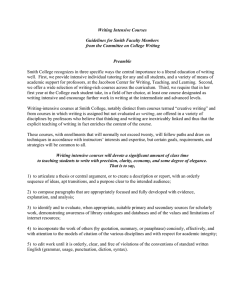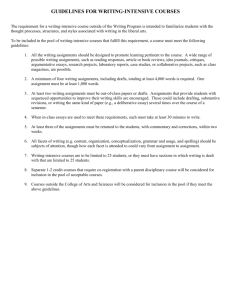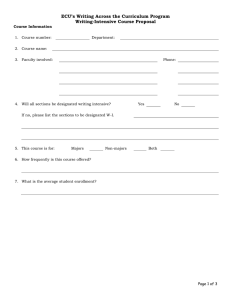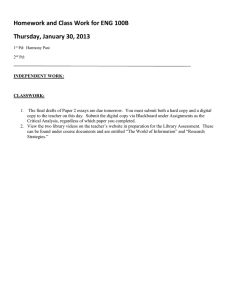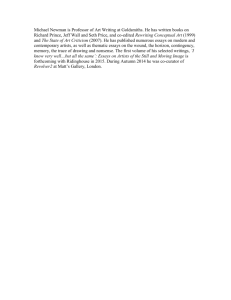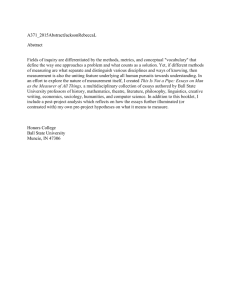1 Nathaniel Krumdick and Kelci Price Department of Psychology, Loyola Chicago
advertisement
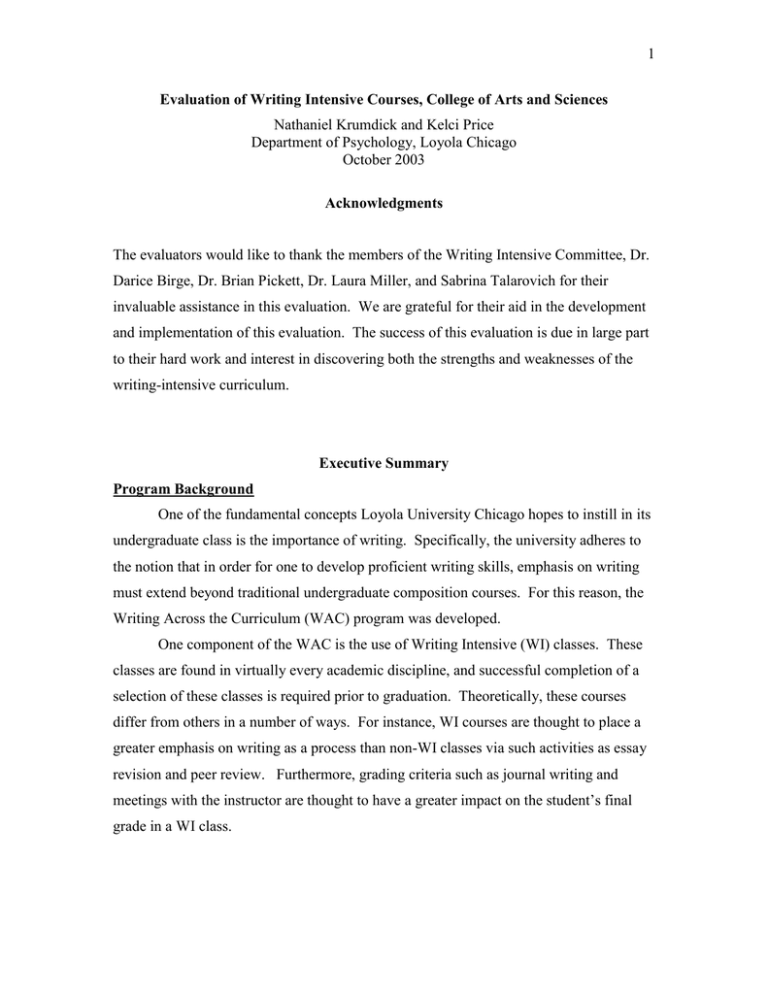
1 Evaluation of Writing Intensive Courses, College of Arts and Sciences Nathaniel Krumdick and Kelci Price Department of Psychology, Loyola Chicago October 2003 Acknowledgments The evaluators would like to thank the members of the Writing Intensive Committee, Dr. Darice Birge, Dr. Brian Pickett, Dr. Laura Miller, and Sabrina Talarovich for their invaluable assistance in this evaluation. We are grateful for their aid in the development and implementation of this evaluation. The success of this evaluation is due in large part to their hard work and interest in discovering both the strengths and weaknesses of the writing-intensive curriculum. Executive Summary Program Background One of the fundamental concepts Loyola University Chicago hopes to instill in its undergraduate class is the importance of writing. Specifically, the university adheres to the notion that in order for one to develop proficient writing skills, emphasis on writing must extend beyond traditional undergraduate composition courses. For this reason, the Writing Across the Curriculum (WAC) program was developed. One component of the WAC is the use of Writing Intensive (WI) classes. These classes are found in virtually every academic discipline, and successful completion of a selection of these classes is required prior to graduation. Theoretically, these courses differ from others in a number of ways. For instance, WI courses are thought to place a greater emphasis on writing as a process than non-WI classes via such activities as essay revision and peer review. Furthermore, grading criteria such as journal writing and meetings with the instructor are thought to have a greater impact on the student’s final grade in a WI class. 2 Evaluation Focus In its 10-year history, no formal evaluation of the WAC program has been conducted. It is with the intention of addressing this deficiency that this particular research is focused. Specifically, the researchers sought to determine the general characteristics of WI and non-WI courses, and examine the degree to which these characteristics differ from one another. Additionally, an investigation into the impact of individual teaching style on the manner in which WI courses are taught was conducted, along with an exploration of the differences in WI implementation across various academic programs. Conclusions Certain patterns emerged in the process of this evaluation. In summary: WI courses tend to rely more heavily on qualitative measures of performance (e.g., essay and in-class writing activities), while non-WI classes used more quantitative measures of achievement (e.g., quizzes and exams). The use of progressive writing strategies (e.g., essay revisions) was more prevalent in WI courses than non-WI classes. There exists little variation between WI and non-WI classes that are taught by the same instructor. The general patterns observed differentiating WI from non-WI classes remains when examined across academic disciplines. Recommendations Based upon these findings, a variety of recommendations can be made: Determine whether the current usage of the various grading criteria meets the expectations of the writing-intensive curriculum. Evaluate the appropriateness of using identical syllabi for both WI and non-WI classes. Consider creating a formal standard for designating a class “writing-intensive.” 3 Program Description: Writing Across the Curriculum program at Loyola University Chicago Loyola University Chicago adheres to the notion that an essential component of a student’s college education is that they learn “to write clearly, persuasively, and gracefully.” To this end, Loyola University has implemented a program designed to teach students about the process of writing and to ensure that students both maintain and improve their writing capability during their undergraduate careers. This program is called Writing Across the Curriculum (WAC). The WAC program is required of all students and is part of the undergraduate curriculum. It has three main components: composition courses, writing-intensive courses, and curricular commitment. The first requirement is composition courses, which consist of two freshman writing classes (English 105 and 106) that are taken by most students. The second requirement is that students take two classes which are designated writing intensive. These courses are mainly at the 100 and 200 level in core curriculum courses, although some are at the 300 level within various majors. The third and final component is curricular commitment, which refers to the fact that all university faculty members attempt to include in their courses a significant amount of writing. Curricular commitment ensures that students are exposed to significant amounts of writing, which allows them to continually learn and refine writing skills. There are several reasons that the WAC approach was adopted by Loyola University. One of the main principles associated with learning to write is that writing must be spread both horizontally and vertically in a curriculum. Horizontal writing means that students are exposed to writing in classes of all disciplines in their undergraduate curriculum. This promotes writing proficiency in the styles of all disciplines, which can be vastly different between academic areas. The concept of vertical writing means that students practice writing in all classes throughout their course of study, rather than concentrating the learning of writing into freshman English classes. Spreading the learning and practice of writing over students’ course of study ensures that students both maintain and refine their writing skills over time. There are two additional principles that guide the WAC program. The first principle is that the instruction of writing should promote writing as a process. The focus 4 is therefore placed on teaching students how to analyze a subject and organize the stages of their writing. Lastly, WAC is important because students learn the course material more effectively and deeply when they write about it. For these reasons, Loyola University feels it is an essential to emphasize the learning of writing throughout a student’s undergraduate career. Focus of the Evaluation This evaluation focuses on the writing-intensive (WI) component of the curriculum. WI courses are specifically designed so that students will learn writing skills in different disciplines, and that the learning will be spread throughout their college career. Students are required to take at least two WI courses, and are not allowed to take them at the same time. This encourages students to take WI courses in different disciplines and ensures that they are reasonably spread across the student’s undergraduate curriculum. Impetus for evaluation of the writing-intensive curriculum There are two main reasons that this evaluation was deemed to be essential. Firstly, the WI courses are an important part of the Writing Across the Curriculum program. Despite the fact that the WAC program (including WI courses) was implemented over 10 years ago, as of 2003 no evaluation had yet been undertaken to determine if writing-intensive courses were being implemented as had been outlined in the original implementation plan. Secondly, anecdotal evidence suggested there were potentially a few problems with the implementation of the WI courses. Some professors mentioned to the evaluators (before the evaluation began) that they had had complaints from students who claimed that the designation of some courses as WI and others as not WI was unfair. The students felt that some courses that were designated non-WI had an equal or greater amount of writing than WI courses. Although the goal of WI courses is not merely to have a greater amount of writing than other courses, the evaluators felt that there may be a legitimate concern that the designation of courses as WI and non-WI courses may not be strongly linked to their writing content. Comments from professors that emerged in the early 5 stages of the evaluation also highlighted concerns about the implementation of WI courses. Since both faculty and students had expressed concerns, the evaluators felt that an evaluation of the implementation of WI criteria was warranted. Questions the Evaluation is Designed to Answer This evaluation was designed to answer five main questions: 1. What are the characteristics of writing-intensive courses as they are implemented? 2. Are the characteristics of writing-intensive courses as expected based on stated objectives in the WAC program? 3. What are the characteristics of non-writing intensive courses? 4. How do the non-writing intensive and writing intensive courses differ and in what ways are they the same? 5. Are the differences between writing intensive and non writing-intensive those that were expected? 6. What are the differences in the content of writing-intensive courses between departments? Questions 1 and 2 examine the characteristics of writing-intensive courses as they are currently implemented at Loyola University and seek to determine whether or not the characteristics of these courses are those that were originally outlined as part of the WAC program. Question 3 is designed to determine the characteristics of the non-writing intensive courses, which form the basis of comparison for the writing intensive courses. Question 4 relates to the ways in which writing intensive and non-writing intensive courses compare, while question 5 looks at whether these differences were those that were expected in the original writing-intensive program. Question 6 takes a more finegrained approach, and asks whether there are differences in the characteristics of writingintensive classes between departments. 6 Stakeholders Stakeholders for this evaluation include the Writing Intensive Committee, Academic Council, professors (particularly those who teach writing-intensive courses), and undergraduate students. The Writing Intensive Committee was formed in 2003 prior to this evaluation by Dr. Darice Birge from the Office of the Dean in the College of Arts and Sciences, with the goal of evaluating the writing-intensive curriculum. This committee includes Dr. Darice Birge, Dr. Brian Pickett (Biology), Dr. Laura Miller (Anthropology), and Sabrina Talarovich (undergraduate representative). The WI committee kindly incorporated the evaluators into their meetings and into their evaluation plans, and played a key role in this evaluation. Methods At the beginning of the evaluation the evaluators contacted Dr. Birge to obtain informational pamphlets about the Writing Across the Curriculum program, one of which was developed for faculty and the other one of which was developed for students. These pamphlets provided background information on the WAC program, and stated the goals and objectives of the WI courses. In consultation with the Writing Intensive Committee, it was decided that the evaluation of the writing-intensive curriculum would be multi-phased. The first phase of the evaluation would be conducted by the present evaluators and would involve an investigation of the implementation of writing-intensive criteria in current WI classes. Specifically, certain characteristics of WI courses outlined in the informational pamphlets were deemed central to the objectives of the Writing Across the Curriculum program by the WI committee, and subsequently used to determine the program’s degree of implementation (please see Appendix A for these characteristics). In conjunction with committee members, the evaluators developed a list of questions that needed to be answered by the evaluation. The informational needs of the committee suggested to the evaluators than an analysis of class syllabi could be used to determine how WI criteria were being implemented. It was decided that the evaluation of 7 the implementation of WI criteria would be limited to classes taught in the last five years (1998-2003). The committee had already collected some syllabi. These were given to the evaluators and were used as the basis for the collection of more syllabi. It was decided to set a goal of obtaining syllabi from 50% of the WI courses. Three comparison groups were selected. The first syllabi in the first group were from WI classes. The second group was comprised of syllabi from non-WI classes that were the same course as the WI class and taught by the same professor. The final group consisted of non-WI classes that were different from the WI courses, and taught by different professors. Overall, 60 syllabi were identified for collection. The relevant professors were e-mailed and their syllabi collected over a span of about 6 weeks. Reminder e-mails were sent out as necessary. Overall, 55 syllabi were returned out of the 60 requested. This led to a response rate of 91.7%. Please see Appendix B for more detailed figures pertaining to the number of syllabi of each comparison group requested and subsequently collected. The syllabi were then content analyzed. An exhaustive list of the types of grading criteria used in both WI and non-WI was created. This list was presented to the Writing Intensive Committee, and changes were made based on their suggestions. The final coding list can be found in Appendix C, and reflects two basic categories. Syllabi were first analyzed to identify grading criteria (e.g., the presence of exams, essays, etc.). Then, each grading criteria was coded to reflect conditional elements (e.g., whether or not drafts were used for the grading criteria, whether or not it actually contributed towards the student’s overall grade in the class, etc.). Following content analysis, comparative analysis were conducted on the data using SPSS to compare the various grading criteria and subsequent conditional elements across writing intensive and non-writing intensive courses. Please note that a more detailed Methods section is available in Appendix F. 8 Results Characteristics of Writing-Intensive Classes The first analysis conducted looked at the type of grading criteria used in WI courses. As can be seen in Table 1 (Appendix D), the most often used grading criteria in writing intensive classes were exams, which were used in 68.8% of classes. However, from the syllabi it could not be determined whether these exams necessarily included writing components. In terms of writing exercises, the most popular by far were medium essays (59.4%), followed by short essays (43.8%) and long essays (37.5%). Writing exercises that were moderately used included in-class writing (28.1%) and non-essay homework (21.9%). The most infrequently used writing criteria were journals, which were used in only 12.5% of classes. Of the conditional elements that were examined, the use of drafts in writing assignments was of paramount interest because it was thought to be a fundamental component of writing-intensive courses. Of those writing-intensive classes using takehome writing assignments, 35.7% stressed the use of drafts on short essays, 36.8% on medium essays, and 50.0% on long essays. Please see Table 2 for these findings. Characteristics of Non-Writing Intensive Classes The second analysis looked at the characteristics of non-writing intensive courses. Non-WI courses were found to use all the same grading criteria as WI courses with one exception: no non-WI classes used meetings with the professor as a component of the student’s final grade. As can be seen in Table 3, by far the most popular assessment in non-writing intensive courses was exams, which were used in 87% of courses. The second most popular grading component was class participation (65.2%). In terms of writing assignments, the most frequently used were long essays (39.1%), medium essays (26.1%), and short essays (21.7%). The least frequently used types of writing assessments were journals and non-essay homework (both 13%). Also, for comparative purposes, an investigation into the use of drafts in takehome writing assignments by non-writing intensive classes was conducted. Of those classes using take-home writing assignments none used drafts on short essays, 33.3% 9 used drafts on medium essays, and 11.1% on long essays. Please see Table 4 for these findings. Comparison of writing-intensive and non writing-intensive classes with same professor Differences in writing intensive and non-writing intensive courses were also examined across the same courses taught both WI and non-WI by the same instructor. This provides a ‘pure’ measure of the differences between WI and non-WI courses, because it controls for the type of course and the instructor. However, this also creates a potential problem because professors who teach WI classes may be fundamentally different in their teaching style to those who do not teach WI classes. For this reason, two comparison groups were used, same teacher/same course and different teachers/different course. The above comparisons combine both these groups, whereas this comparison looks only at same teacher/same course. As can be seen in Table 5, the largest difference between WI and non-WI courses with the same professor occurs for medium essays. In WI courses, 60% use medium essays whereas in non-WI courses only 30% use medium essays. All other grading criteria occur in fairly similar percentages between WI and non-WI courses which have the same professor. Comparison of writing-intensive and non writing-intensive across academic programs The final analyses focused on the grading characteristics across academic disciplines. The same criteria previously examined were now investigated across different academic programs, as well as across WI and non-WI courses within each department. Please see Tables 6 and 7 for detailed findings. In general, courses within the Social Science curriculum used long essays most, with 57.1% of the sampled classes using this grading criterion. Communications curriculum used the most in-class writing (43.5%), medium length essays (60.9%), and class participation (73.9%), while Art classes tended to use the most non-essay homework (17.4%) and class presentations (66.7%). Humanities courses used short essays (52.6%), quizzes (47.4%), and exams (89.5%) most of all. The use of drafts in writing assignments was similarly examined across academic disciplines. This analysis revealed that drafts on short and medium essays are most 10 frequently used by Communication courses (37.5% and 42.9% respectively), while classes in the Social Science curriculum most frequently uses drafts for long essays (75.0%). The final analysis focused on examining the usage of the various grading criteria across WI and non-WI classes within individual academic disciplines. Detailed findings of this analysis can be found in Table 8. It should be noted that, due to small sample sizes within each category, these comparisons are somewhat provisional. However, one pattern that seems to emerge is that, on average, WI classes tend to use more qualitative measures of achievement (i.e., essays of all lengths, in-class writing, etc.), while non-WI classes typically use more quantitative measures (i.e., quizzes, exams, etc.). For instance, 73.3% of sampled WI Communications classes use medium length essays, while only 37.5% on non-WI Communications classes do so. Furthermore, while only 50% of WI Art classes use exams as a grading criterion, 100% of the sampled non-WI classes do so. While this trend is not absolute for all academic disciplines, it does seem to replicate the pattern previously observed in the initial global evaluation of differences in grading criteria usage. Conclusions From these findings, several interesting conclusions can be drawn. These will be discussed with reference to the evaluation questions stated earlier. How do the characteristics of writing-intensive differ from those of non writing-intensive courses? Writing-intensive classes used grading criteria consisting of short and medium essays substantially more often than non-WI classes. WI classes also tended to use inclass writing, non-essay homework, and presentations more frequently compared to nonWI courses. Only WI courses contained meetings with the professor, but this was very infrequently used. In contrast, non-writing intensive classes tended to use quizzes and exams with much greater frequency than WI classes did. Both WI and non-WI courses used journal writing, long essays, participation and presentations to approximately the same extent. In terms of the use of drafts, it was found that WI courses used drafts 11 substantially more for short and long essays, but not for medium essays. Overall, WI courses were found to use some writing assignments much more than non-WI classes. However, it was surprising that WI courses did not use more drafts for medium essays than non-WI courses did. Do writing-intensive and non-writing intensive courses differ in the expected ways? The findings from this evaluation indicate that writing-intensive classes are currently meeting some of the tenets of the writing-intensive program, while others remain unfulfilled. Writing assignments such as short and medium essays, and in-class writing were indeed more frequent in WI courses, indicating that these classes are using writing as a tool for learning. The more frequent use of drafts for short and long essays in WI classes suggests that these courses are focusing on the process of writing, rather than the sheer volume of written text. Also, as expected, non writing-intensive classes tended to rely more heavily on quantitative grading criteria. In these courses, the process of writing appears to be de-emphasized in favor of quizzes and exams as a means of determining course performance. Overall, WI courses tended to use more writing based exercises than non-WI classes. This was expected based on the goals of the writing-intensive program, and indicates that WI classes are indeed meeting some of the criteria of the writing-intensive program. While these findings suggest that the tenets of WI courses have been implemented to some extent, there is still some cause for concern. One of the major concerns is with the use of drafts. Drafts are considered a significant part of the writing-intensive program because they are an obvious way of providing students with feedback on their writing, and allowing them the chance to improve their writing skills. Although WI classes used drafts more than non-WI classes did for short essays and long essays, the actual percentage of WI classes using drafts was surprisingly low. Approximately 36% of WI classes used drafts for short and medium essays, while 50% used drafts for long essays. Considering that drafts are assumed to be such an essential part of WI courses, it is disappointing that so few WI courses actually used them. 12 Additionally, the analysis of the same class being taught WI and non-WI by the same instructor revealed that there is little variation in course curriculum in these classes, regardless of whether they were designated WI or not. While professors did tend to assign more medium length essays in writing intensive sections of their classes (60.0% versus 30.0%), there was little or no variation in every other grading criteria examined. Furthermore, the use of drafts in these courses did not differ between WI and non-WI courses except in the case of short essays. This suggests that these instructors do not differentiate between WI and non-WI sections of the same class. The evaluators and committee had expected this, since several professors directly reported to the evaluators that they utilized the same syllabus for both WI and non-WI sections. This evaluation does not presume to draw a conclusion about whether it is positive or negative that writing intensive professors tend to teach all their classes with a high emphasis on writing. A positive aspect of this is that students are being exposed to the process of writing even when they are not in a class that is required to directly focus on writing skills. This will serve to improve their writing skills. A negative aspect of this is that students in the non-WI sections are completing the same work as students in the WI sections, and yet are not getting credit for the WI component. Further discussion by the Writing Intensive Committee on this issue is needed to determine the impact and importance of this finding. In some respects it is very difficult for this evaluation to determine whether writing-intensive courses are meeting the implementation criteria originally determined by Loyola University. One reason for this is that there is no formal standard which WI courses can be compared against to ensure that they are meeting set criteria. Professors of WI classes are given a workshop on the importance of the process of writing and how to implement writing techniques in their classes, but they are then left to their own discretion about how to implement the techniques and to what extent. Because of the lack of a formal standard, it is nearly impossible to draw firm conclusions about whether the current WI classes are meeting expected levels of implementation of WI characteristics. 13 What are the differences in the content of writing-intensive courses between departments? An additional concern is raised by comparisons across academic disciplines1. Distinct patterns of grading criteria usage emerge when examined in the context of academic program. For instance, classes in the Communications curriculum tend to use the most in-class writing, medium length essays, and participation. Social Science classes tend to use the most long essays, while classes in the Arts seem to use the most non-essay homework and class presentations. Finally, Humanities classes tended to use the most short essays, quizzes, and exams. No single curriculum seemed to use journal writing or meetings with professors with any significant frequency. Naturally, one can expect fluctuations in the use of certain grading criteria according to course curriculum. Certain subjects logically tend to be measured one way over another (e.g., you would not traditionally measure math proficiency with an essay). For this reason, differences in grading criteria were examined across academic disciplines as a function of writing intensive and non-writing intensive course sections2. For the most part, writing intensive courses did tend to use more in-class writing, non-essay homework, short essays, medium essays, long essays, and meetings with the professor. Non-writing intensive classes across the various academic disciplines tended to use more quizzes and exams, while little variation of the use of presentations and participation was observed across writing intensive and non-writing intensive classes (please see Table 9 for these figures). Recommendations In general, the writing-intensive section of the Writing Across the Curriculum program has been implemented with a certain degree of success. Classes with the writing-intensive designation do tend to place a greater level of emphasis on the elements of writing outlined by the Writing Across the Curriculum, while non-writing intensive classes tend to rely more on quantitative measures of achievement. However, there are 1 It should be noted again that, due to sample size, conclusions drawn from these particular analyses are tentative at best. 2 Only applicable findings are discussed (e.g., if a curriculum did not use a grading criterion in either writing intensive or non-writing intensive courses, they are omitted). 14 some areas in which ‘fine-tuning’ may improve the implementation of the writingintensive program. The following recommendations are designed to aid in a consideration of ways in which the strengths and weaknesses of writing-intensive courses can be identified. a) Determine whether the current levels of usage of various grading criteria are meeting the expectations of the writing-intensive curriculum o This evaluation has described the differences between WI and non-WI classes, but it cannot determine whether these differences are appropriate and reflect the expectations of the writing-intensive curriculum. o It is suggested that a committee consider the differences found and determine which writing-intensive criteria are being well utilized in WI classes, and which need to be encouraged. b) Determine the appropriateness of using identical syllabi for both WI and non-WI classes. o Because some students have expressed discontent with non-WI classes to the effect that they feel they include the same amount of writing as WI classes, it is felt by the evaluators that further discussion on this point is critical. Whether it is acceptable for WI and non-WI courses to use identical or very similar syllabi is a decision that will need to be made by the relevant stakeholders (e.g., Writing Intensive Committee or Academic Council). c) Consider creating a formal standard for writing-intensive classes. o Future discussions on WI classes should include consideration of the necessity for, and possible form of a formal WI standard. Creating a formal standard would ensure greater consistency in the characteristics of WI classes, and would ensure that all WI classes were meeting at least minimal expectations. 15 o A standard would also eliminate some of the difference in WI classes across departments. o A formal standard does not have to be problematical for existing WI classes, and can be designed in a way that is flexible enough to recognize the needs of different disciplines. o One possibility is the creation of a ‘checklist’ from which instructors would choose a minimum number of criteria to implement in their WI classes. Limitations to this evaluation One of the major limitations of this evaluation is that because we relied entirely on data provided by the syllabi, any writing related learning that occurred in class but was not mentioned on the syllabus is not recognized in this data. For example, if a teacher held in-class seminars about writing methods or techniques but did not include this on the syllabus, then our data will not reflect this. Therefore, this data may underestimate the amount of writing related learning that occurs in classes and may also fail to recognize types of teaching that occurred (e.g., writing seminars). It is hoped that future evaluations will include discussions with the writing-intensive professors that will explore in more depth the techniques they use in their WI classes to teach the process of writing. Another limitation to this evaluation is that not all WI classes were sampled. Unfortunately, because of time constraints it was not practical for the evaluators to collect all WI syllabi, and so only a sample were taken. For this reason, findings should be interpreted with care. This is especially true in the case of comparing across departments, because in some departments a very limited number of syllabi were collected due to the small number of WI classes offered in that discipline. 16 Appendices Appendix A – Central Characteristics of Writing Intensive Courses Appendix B – Number of syllabi requested/collected from the various comparison categories Appendix C – Syllabus Variable Coding List Appendix D – Tables Table 1: Percentage of writing-intensive courses using each grading criteria Table 2: Percentage of WI courses using drafts for various writing assignments. Table 3: Percentage of non writing-intensive courses using each grading criteria Table 4: Percentage of non-WI courses using drafts for various writing assignments. Table 5: Percentage of WIC and Non-WIC taught by the same instructor using each type of grading criteria Table 6: Percentage of grading criteria used in each academic program. Table 7: Percentage of draft use by academic program. Table 8: Percentage of grading criteria used by WIC and Non-WIC across academic programs Appendix E – Agreements Appendix F – Detailed Methods Section 17 Appendix A Central Characteristics of Writing Intensive Courses as Determined by the Writing Intensive Committee in 2003 Essay writing Journal writing In-class writing exercises The use of drafts Peer review of writing assignments Writing assignments progressive within a common theme Appendix B Number of syllabi requested/collected from the various comparison categories Syllabus Category Writing Intensive Non-WI: Same course instructor Non-WI: Different course instructor Total Number Requested 21 21 18 60 Number Collected 32 10 13 55 18 Appendix C Syllabus Variable Coding List Grading Criteria – Items used in determining a student’s final course grade In-class writing Journals Non-essay take-home assignments Short essays (1-3 pages) Medium essays (4-6 pages) Long essays (7 pages and up) Quizzes Exams Presentations Meetings with the instructor Class Participation Conditional Elements – Characteristics of the above grading criteria* Drafts Peer Review Graded Progressive within a common theme *Please note that these elements logically do not apply to the following grading criteria: quizzes, exams, presentations, meetings with the instructor, and class participation Miscellaneous – Other variables necessary for analysis Course number Writing intensive designation Academic program 19 Appendix D Table 1. Percentage of writing-intensive courses using each grading criterion (n=32). Grading Criteria In-Class Writing Journals Non-Essay Homework Short Essays (1-3 pages) Medium Essays (4-6 pages) Long Essays (7+ pages) Quizzes Exams Meetings with Professor Participation Presentations % using criteria 28.1 12.5 21.9 43.8 59.4 37.5 28.1 68.8 12.5 59.4 15.6 Table 2. Percentage of WI courses using drafts for various writing assignments. Grading Criteria Short Essays (1-3 pages) Medium Essays (4-6 pages) Long Essays (7+ pages) % using drafts 35.7 36.8 50.0 20 Table 3. Percentage of non writing-intensive courses using each grading criteria (n=23). Grading Criteria In-Class Writing Journals Non-Essay Homework Short Essays (1-3 pages) Medium Essays (4-6 pages) Long Essays (7+ pages) Quizzes Exams Meetings with Professor Participation Presentations % using criteria 17.4 13.0 13.0 21.7 26.1 39.1 39.1 87.0 0 65.2 8.7 Table 4. Percentage of non-WI courses using drafts for various writing assignments. Grading Criteria Short Essays (1-3 pages) Medium Essays (4-6 pages) Long Essays (7+ pages) % using drafts 0 33.3 11.1 Table 5. Percentage of WIC and Non-WIC taught by the same instructor using each type of grading criterion (n=10). Grading Criteria In-Class Writing Journals Non-Essay Homework Short Essays (1-3 pages) Medium Essays (4-6 pages) Long Essays (7+ pages) Quizzes Exams Meetings with Professor Participation Writing Intensive 40.0 10.0 30.0 40.0 60.0 30.0 40.0 80.0 10.0 50.0 Non-Writing Intensive 30.0 10.0 30.0 30.0 30.0 40.0 40.0 90.0 0.0 70.0 21 Presentations 10.0 10.0 Table 6. Percentage of grading criteria used in each academic program. Grading Criteria In-Class Writing Journals Non-Essay Homework Short Essays (1-3 pages) Medium Essays (4-6 pages) Long Essays (7+ pages) Quizzes Exams Meetings with Professor Participation Presentations Comm. Natural Sciences 0 Arts Humanities 43.5 Social Sciences 14.3 0 10.5 17.4 17.4 0 42.9 0 0 0 66.7 15.6 5.3 34.8 14.3 0 0 52.6 60.9 14.3 0 33.3 47.4 30.4 57.1 33.3 33.3 42.1 26.1 73.9 28.6 71.4 0 33.3 33.3 66.7 47.4 89.5 4.3 14.3 0 0 10.5 73.9 13.0 42.9 0 33.3 33.3 33.3 66.7 63.2 5.3 Table 7. Percentage of draft use by academic program. Type of Writing Short Essays (1-3 pages) Medium Essays (4-6 pages) Long Essays (7+ pages) Comm. Natural Sciences 0 Arts Humanities 37.5 Social Sciences 0 0 10.0 42.9 0 0 0 33.3 14.3 75.0 0 0 25.0 22 Table 8. Percentage of grading criteria used by WIC and Non-WIC across academic programs. Comm. Grading Criteria In-Class Writing Journals WI Social Sciences WI NWI 33.3 0 Natural Sciences WI NWI 0 0 Arts WI Humanities 46.7 NWI 37.5 WI N-WI 0 NWI 0 10.0 11.1 20.0 12.5 0 0 0 0 0 0 10.0 22.2 Non-Essay Homework Short Essays (1-3 pages) 20.0 12.5 66.7 25.0 0 0 50.0 100 10.0 0 46.7 12.5 33.3 0 0 0 0 0 60.0 44.4 Medium Essays (4-6 pages) Long Essays (7+ pages) Quizzes Exams 73.3 37.5 33.3 0 0 0 50.0 0 60.0 33.3 26.7 37.5 66.7 50.0 50.0 0 50.0 0 40.0 44.4 20.0 73.3 37.5 75.0 0 33.3 50.0 100 0 0 0 100 50.0 50.0 0 100 50.0 90.0 44.4 88.9 Meetings with Professor Participation Presentations 6.7 0 33.3 0 0 0 0 0 20.0 0 73.3 13.3 75.0 12.5 33.3 0 50.0 0 50.0 50.0 0 0 0 50.0 100 100 60.0 10.0 66.7 0 Appendix E Agreements This evaluation was not requested by the Writing Intensive Committee. As a course project for their Program Evaluation course, the two evaluators (second year PhD students in Applied Social Psychology) were seeking a project. In a discussion with a professor about the project, it was suggested to one of the evaluators that they consider doing a project on the WI curriculum. The Writing Intensive Committee kindly permitted the evaluators to join their committee in planning and carrying out this evaluation. 23 Appendix F Detailed Methods Section This evaluation began with the evaluators contacting Dr. Birge in order to obtain two informational pamphlets about the Writing Across the Curriculum program, one of which was developed for faculty and the other one of which was developed for students. These pamphlets provided background information on the WAC program, and stated the goals and objectives of the WI courses. The evaluators were invited by the WI committee to come to their meetings and participate in planning an evaluation of the WI courses. The evaluators met with the committee in order to develop evaluation goals for both groups that would be compatible and complimentary. In these meeting the evaluators learned what information the members were interested in obtaining. Following a review of the goals of the evaluation, it was decided that the process of evaluating the WI curriculum would be multi-phased. Gathering information about the current implementation of the WI courses was determined to be the first phase, and it was agreed that this would be carried out by the evaluators. Future phases would be conducted in the future, and would involve more indepth information gathering. Research by Dr. Birge into evaluations of WI courses at other universities showed that George Mason University had developed a very similar type of implementation evaluation. A list of questions that needed to be answered by the evaluation was developed by the evaluators in conjunction with committee members. The informational needs of the committee suggested to the evaluators than an analysis of class syllabi could be used to determine how WI criteria were being implemented. It was decided that the evaluation of the implementation of WI criteria would be limited to classes taught in the last five years (1998-2003). Some syllabi had already been collected by the committee. These were given to the evaluators and were used as the basis for the collection of more syllabi. It was decided to set a goal of obtaining syllabi from 50% of the WI courses. Three comparison groups were selected. Firstly, 61 syllabi from WI classes were identified. Then, a nonWI comparison group was created comprising two parts. 21 classes were identified that were non-WI classes which exactly matched a WI class and was taught by the same 24 instructor. Because these classes had the same teachers it was necessary to create a second comparison group in order to avoid confounding teaching style with WI characteristics. To this end, the committee identified 21 additional classes that were in the same or similar departments and of a similar level to the WI classes chosen, but that had different instructors. Overall, 60 syllabi were identified for collection. One of the evaluators e-mailed all the professors whose classes had been chosen for syllabus collection and informed them about the nature of the project. The professors were asked to return their syllabi by a certain deadline. After this date, the evaluator again e-mailed any professors who had not returned syllabi. Data collection was thus completed in several stages over about 6 weeks. The evaluator corresponded by e-mail with professors who had questions or concerns about the project. Overall, 55 syllabi were returned out of the 60 requested. This led to a response rate of 91.7%. Once the syllabi were collected, they were content analyzed by the evaluators. To begin with, an exhaustive list of the types of grading criteria used in both WI and non-WI courses was created. This list was presented to the Writing Intensive Committee, and changes were made based on their suggestions. The final coding list can be found in Appendix C, and reflects two basic categories. To begin with, syllabi were content analyzed to identify grading criteria (e.g., the presence of exams, essays, etc.). Then, each grading criteria was coded to reflect conditional elements (e.g., whether or not drafts were used for the grading criteria, whether or not it actually contributed towards the student’s overall grade in the class, etc.). Following content analysis, comparative analyses were conducted on the data. Specifically, SPSS was used to compare the various grading criteria and subsequent conditional elements across writing intensive and non-writing intensive courses. Analyses were also conducted examining the characteristics of classes taught as both writing-intensive and non-writing intensive by the same instructor. Finally, analyses were performed that investigated differences in the characteristics of writing-intensive and non-writing intensive courses across academic programs.
